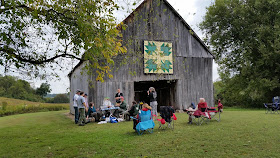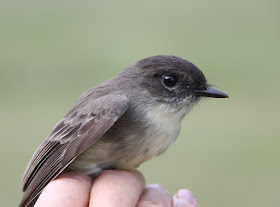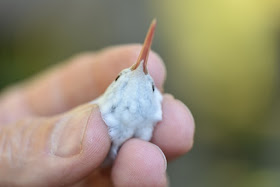This is the second in a two-part series on the October 11th banding session at Seven Islands State Birding Park, Tennessee, with Mark Armstrong and Billie Cantwell banding. The first post can be found at this link: A Palm Warbler Kind of Day
Photo credit: Patty Ford
Fall is always an exciting season as migrants are moving through the area and wintering species are just arriving. Seven Islands provides a unique and exciting habitat for studying birds. Situated on more than 410 acres along the French Broad River, the park offers a combination of shrubby and native grassland habitat with food sources that attract many migrating warblers, wintering sparrows and other species.
Above, a female Hooded Warbler. Hooded warblers breed in eastern North America, including Tennessee, and winter in the West Indies, Mexico, to Panama. They live and forage in low, dense understory, often near water. Photo credit: Colin Leonard
Nineteen species were processed during the banding session with a total of 122 birds banded and 12 recaptures (birds previously banded), totaling 134. Among the warblers and sparrows banded were 13 Common Yellowthroats, 1 Magnolia warbler, 57 Western Palm Warblers, 1 Yellow Palm Warbler, 1 Hooded warbler, 17 Field Sparrows, 1 Chipping Sparrow, 2 Savannah Sparrows, 6 Swamp Sparrows and 5 Song Sparrows.Members of the banding team go to the nets to extract birds at regular intervals beginning at 7:40 a.m. with the period for banding lasting until approximately 11:00 a.m. depending on weather conditions. When captured, each bird is placed in a small cloth bag while waiting to be processed. The bag helps keep the bird calm and safe until it is banded and set free again.
Above and below, images of a male Magnolia Warbler (Setaphaga magnolia). Magnolia Warblers breed in northern boreal forests and migrate to wintering grounds in Mexico and the West Indies to Panama. Their conspicuous bright yellow and black breeding plumage with distinct tail markings make them one of the most easily recognized warblers. The Magnolia warbler you see here is in his fall or non-breeding plumage. Black markings around his face have faded to gray, as well as the streaked black necklace that is present during breeding season.
The distinctive band of white in the outer tail feathers of the Magnolia Warbler is shown above and is unique to this warbler species.
Magnolia Warblers also has a bright yellow rump which often causes them to be confused with the Yellow-rumped Warbler, but their bright yellow breast is an obvious distinction between species..
Above and below, Magnolia Warbler
Banding team members return from the nets to bring birds back to the banding station.
Below, taking a break between net runs.
Above, Billie Cantwell places a band on an Indigo Bunting. Birds are banded and then examined for information that helps to identify their age, sex, and relative health at the time they were captured.
Wing measurements and tail measurements are taken.
If it is possible to determine the sex of the bird, this information is also recorded, along with the amount of fat found on the bird's belly. A large amount of fat during migration indicates a healthy, well-nourished bird.
All of the data collected is recorded on a banding sheet, shown above, and will be reported to the United States Geological Banding Laboratory. Photo credit: Colin Leonard
Age is determined by examining the wing feathers, including colors, length, and relative wear. The skull is also examined for ossification. Photo credit Colin LeonardAbove, you see the wing of an Indigo Bunting. The bird is being held in a "banders grip" during examination. This grip supports the birds body while it is being examined. Photo credit: Colin Leonard
In the image above, Mark Armstrong is about to touch an Eastern Phoebe's bill, but he gets a surprise. The phoebe snaps his beak making a loud clap. Phoebes are known to snap their bills during aggressive territorial interactions with other phoebes.
Eastern Phoebe Photo credit: Colin Leonard
Visit the first post in this two-part report on banding: A Palm Warbler Kind of Day
Visit my previous posts on bird banding
Visit the Knoxville Chapter of TOS on Facebook
Seven Islands Wildlife Refuge now Seven Islands State Birding Park









































